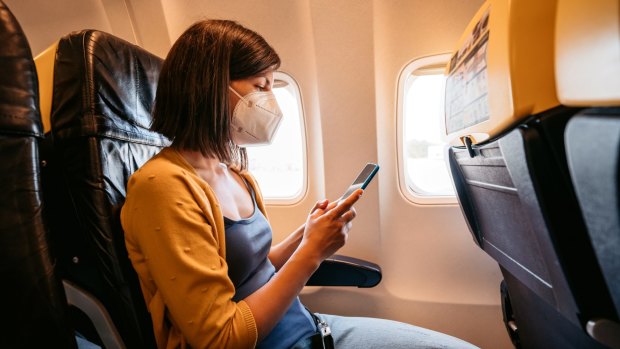This was published 1 year ago
Wearing masks on flights: Travellers should wear masks no matter what the rules are
By Lee Tulloch

Masks may no longer be mandated by some airlines, but travellers should still be wearing them.Credit: iStock
The flight to Singapore mandated the wearing of face masks for passengers six years and above. Although many airlines worldwide have abandoned the rule, including those that fly Australian domestic routes, Singapore Airlines still requires masks during the flight, in line with Singapore's strict regulations.
But even with a mandate some people don't get it. The man who plonked himself in the seat next to me wore a loose-fitting cloth mask that immediately fell under his chin. As we took off, he nodded off to sleep, heavily breathing out particles through his nose and mouth. I was wearing a tight-fitting KN95 mask but I knew there was more risk if the passenger next to me didn't wear one, despite the airline's high-efficiency particulate air (HEPA) filters.
I was just starting a long trip and I didn't want to spend it in quarantine. I hesitated before politely asking him to pull it up, because I didn't want to be that person. He did so immediately. But the mask slipped back down under his chin after a while and stayed there throughout the flight.
I didn't catch COVID-19. But friends flying from Stockholm to Paris next to an unmasked person who was coughing and sneezing certainly did.
I'm astounded to find that I'm still writing about mask-wearing at this stage of the pandemic. For travellers, a properly fitted mask is a nuisance but it's still a major line of defence, after vaccines and boosters. That mask might be the difference between a good trip and one that's ruined by costly and inconvenient illness. One that snowballs beyond you and the person next to you to other more vulnerable people.
Even now, where masks are mandated, such as on public transport, few wear them, with not much of a tick up now that BA.5 is rampant. How something so practical became a sensitive subject even for governments is one of the crazier aspects of the world we live in, one for the history books – if we have any history.
I'm someone who still wears my mask in the supermarket. I've had all the available vaccines. I probably won't get dangerously sick if I get it, which seems almost inevitable these days. And while my mask sometimes gets a bit itchy after several hours of wearing, I've become used to it. I find a black mask disturbs my peripheral vision less; that the tighter the fit the less my glasses fog up.
Looking around a plane, I'll notice that many people opt for the lighter surgical masks or a cotton cloth mask because they're more comfortable. Both are far less than 25 per cent effective, according to many recent studies. Lack of clear government messaging about this is a big problem.
We don't really have much control over who sits next to us on the flight, but if we both have properly fitting masks, the chances of catching anything, including colds, is much slimmer.
As a traveller, I want to be armed with the best information possible. A new large-scale study of several thousand Australian health care workers reported in the American Journal of Infection Control has shown conclusively that well-fitting (no gaps) FFRs (disposable particulate filtering facepiece respirators) are extremely effective. Technically, the masks protect against particles about 0.3 microns in size. Although coronavirus is about 0.1 microns in size it's usually attached to droplets which are larger.
The trial showed that the 3M1806S had the highest protection rate for men and the 3M1860 had the highest pass rate for women and smaller face types.
The N95 respirators are the gold American standard, while KN95 and P2 meet European, Chinese and Australian standards. All have multiple layers of synthetic fabric. The hard cup style with two straps that go around the head is the best, but probably too uncomfortable for a long flight. The flat fold is good, and the duck bill type is considered the least effective of these.
Even with mask-wearing mandates dropped in most countries and on most airlines, smart travellers should consider a good mask as much a part of their travel kit as their passports. It's not just planes, but taxis, airport gates, but anywhere masses of people congregate.
Until there's a vaccine that's more effective in controlling new variants and people are willing to get vaccinated in large numbers, without masks we're doomed to staff shortages, interrupted holidays and a cycle of sickness for a very long time.
lee.tulloch@traveller.com.au
Sign up for the Traveller newsletter
The latest travel news, tips and inspiration delivered to your inbox. Sign up now.